Abstract
This work is a theoretical and ethnographic approach about the city in ruins and the debris left by recent social protests in Plaza Dignidad in Santiago de Chile. In order to move towards an anthropological definition of the debris, we should ask ourselves, what is the debris after the protests and what place does it inhabit inside the city? What can it tell us and what accounts do these cracked and fissured remains contain, hide and destabilize? Why have they become a field of dispute, a field of forgetfulness, discomfort and fascination? Through the ethnographic and photographic records of post–revolt materialities, the analysis is organized into four dimensions: Skin and patina of the environmental memories; Ambivalence of form and destruction; Ghosts and fetish; Affections and topophilia in dystopia. It is concluded that whatever the ruined artifacts may be, they are always —like the residual materials they are— disorganizing and disconcerting the city, forcing it to reread and rewrite its significant forms. Herein may lie a secret fascination in the debris following the detonation of our city.
References
Agamben, G. (2006). Estancias. La palabra y el fantasma en la cultura occidental. Valencia: Pretextos.
Augé, M. (2003). Le temps en ruines. París: Galilée.
Balandier, G. (2003/1988). El desorden. La teoría del caos y las ciencias sociales. Barcelona: Gedisa Editorial.
Baudrillard, J. y Nouvel J. (2007). Los objetos singulares. Arquitectura y filosofía. Buenos Aires: Fondo de Cultura Económica.
Benjamin, W. (2011). Libro de los pasajes. Madrid: Akal.
Déotte. J. L. (1998). Catástrofe y olvido. Las ruinas, Europa, el museo. Santiago de Chile: Cuarto Propio.
Didi–Huberman, G. (1997). Lo que vemos, lo que nos mira. Buenos Aires: Manantial.
Simmel, G. (1988). Sobre la aventura. Ensayos filosóficos. Barcelona: Homo Sociológicus, Ediciones Península. Simmel, G. (2005/1898). Roma, Florencia, Venecia, Barcelona: Gedisa.
STOLER, A.L.(2008). Imperial debris: Reflections on ruins and ruination.nCultural Anthropology 23(2), 191-219. Libro completo publicado por Duke University Press, London y Durnham, 2013, link con acceso en 20 /05/22, disponible en https://www.researchgate.net/publication/298522997_Imperial_debris_Reflections_on_ruins_and_ruination
Taussig, M. (2002). Chamanismo, colonialismo y el hombre salvaje: un estudio del terror y la curación, Trad. Hernando Valencia. Cauca: Universidad del Cauca.
Santos, J. (2019). Lugares espectrales. Topología testimonial de la prisión política en Chile. Santiago de Chile: Colección Idea, Usach.
Stoetze, B. (2018). Ruderal ecologies: Rethinking nature, migration and the urban landscape in Berlin. Cultural Anthropology, 33(2), 295–323. https://doi.org/10.14506/ca33.2.09
Tuan, Y. (2007/1984). Topofilia. Un estudio de las percepciones, actitudes y valores sobre el entorno. Barcelona: Melusina.


